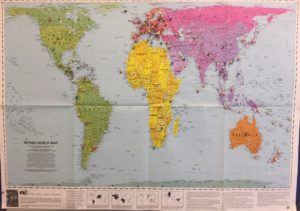There are many worse places than Cape Verde to get stranded, but it’s more likely to happen here than most other countries.
Cape Verde is made up of 10 islands 400 or so miles off the coast of Senegal in West Africa. I had to decide which one to fly to, which ones I’d like to visit (in a short trip of just one week), and then how to get around. I took a direct flight with Thomas Cook airlines from Manchester to Sal. Most other passengers had bought a package of flights and hotel from the company but I had opted for a flight-only deal, for independent travel around the islands. This is the cheapest and easiest way to get into the country but goes to an infertile island which is really just hotels and beaches. So I had pre-booked another local flight out of Sal to the capital of Praia on the island of Santiago. The second flight was in the evening after I arrived in the early afternoon, so I went in Sal airport lounge to use wifi and drink coffee. There’s only so much coffee I can drink and emails I can send, so after a while I went back to the terminal to check in early for my next flight. When I arrived, my flight wasn’t on the departures board, which was a little disconcerting, but I decided not to panic and enquired politely at the offices of Binter Airlines. They informed me that my evening flight had left earlier in the afternoon. Nobody had told me, even though they had my email address. Still resolving to stay calm and telling myself that this is all part of the fun of travelling, I explained my position and enquired about solutions. Luckily, there was a later flight to the island of Sao Vicente, and then another one from there to Santiago. So they rebooked me onto these two flights and it all worked out fine. I got two flights and two islands for the price of one and arrived in Praia at pretty much the same time as I had originally expected.
Cape Verde has a ‘Caribbean’ feel and a slow pace, but with a Portuguese accent and a soundtrack of Cesária Évora melodies. The people are friendly and as the week went on I appreciated their gentleness more and more: there were occasions when their kindness was an unexpected surprise. Praia is a quiet town and the only way you would identify it as a capital ‘city’ is the presence of various embassies, the Chinese and Russian ones being the most prominent. I thought I’d like to go from Praia to the neighbouring volcano island of Fogo, but when I enquired about the ferries, they didn’t go on the right days for me to make it a feasible trip. In any case, by then I’d heard stories of ferries being cancelled at the last minute, so I was keen not to get stranded on an island one ferry and one Binter flight away from Sal airport for my journey home. The weather was overcast most of the week and even chilly at times (especially when I went walking in the mountains), which was disappointing, though when the sun did appear, it was scorching hot, so in some ways it was a blessing because with the sun at its strongest, the heat could be debilitating. There is no public transport really, just taxis and privately run shared minibuses called ‘aluguers’. It’s a chaotic system but it works, kind of. These minibuses wait a long time to get enough customers, then, when you eventually set off, you realise they are just circling around town looking for even more passengers. On one trip to the north of Santiago island, after driving for more than an hour, at a town along the way, they said I needed to transfer to another minibus. So then I had to wait there for another hour or so for the next one to do the same thing. It’s a good job I wasn’t in a hurry! (On the way back, while waiting on the main road for an aluguer, I decided to hitch-hike and soon got a ride all the way back to Praia with a local university lecturer and author who spoke English, so we had an interesting conversation.) So I guess one conclusion about Cape Verde is that transport is a bit unreliable, to say the least.
Cape Verde was a Portuguese colony until it gained independence in 1975. The Portuguese influence was evident when I visited the town of Cidade Vehla, a UNESCO world heritage site, the oldest settlement in Cape Verde and the first European colonial settlement in the tropics. That’s because it was a key staging post in the slave trade. In the town square there is a post that was once used to whip and hang slaves. Local people sell souvenirs to tourists here now and it occurred to me that it was ironic that the cheap jewellery there has echoes of the trinkets once used by Europeans to buy slaves from tribal leaders. It was also poignant to reflect on my own freedom to travel as and where I like. My return journey from Santiago to Sal to England went smoothly, without even a first-world problem of flight delays.
Copyright © David Parrish 2018.
First published 05 November 2018.
Read more travel blogs and David’s travelling lifestyle business.
“Once a year, go someplace you’ve never been before.”
Dalai Lama
Read more travel quotes.
